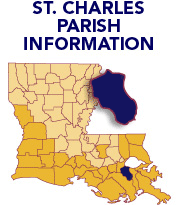St. Charles - What HappenedOn Aug. 29, 2005, Hurricane Katrina made landfall near Buras on the Louisiana Coast east of New Orleans. At landfall, Katrina was at the upper end of Category 3 intensity range with maximum sustained winds estimated at 123 mph. One minute sustained wind strength of 76 mph was recorded along the Pontchartrain Causeway. The level of Lake Pontchartrain rose seven feet, affecting all of the coastal areas surrounding the lake. St Charles Parish was flooded by a lake drainage canal that terminated under the railroad tracks northwest of New Orleans International airport, affecting an estimated 500 homes and 125 businesses. St Charles Parish also suffered high winds that resulted in roof and structural damage. Loss of power caused manufacturers to lose production and there were instances of fires initiated by downed power lines. The parish evacuated approximately 95 percent of the population, while emergency personnel, first responders and essential plant personnel remained throughout the storm event. Unfortunately, emergency evacuation of St. Charles Parish Hospital resulted in the deaths of three critical care patients. The parish experienced secondary storm impacts due to a population increase from evacuees. As a result of additional population, the parish has experienced a significant strain on public infrastructure including water, wastewater and roads. In late January, 2006, the St. Charles Parish Council voted to enact a temporary residential housing moratorium on the east bank of the parish because of severely limited drinking water capacity. Sources: NOAA, FEMA |







